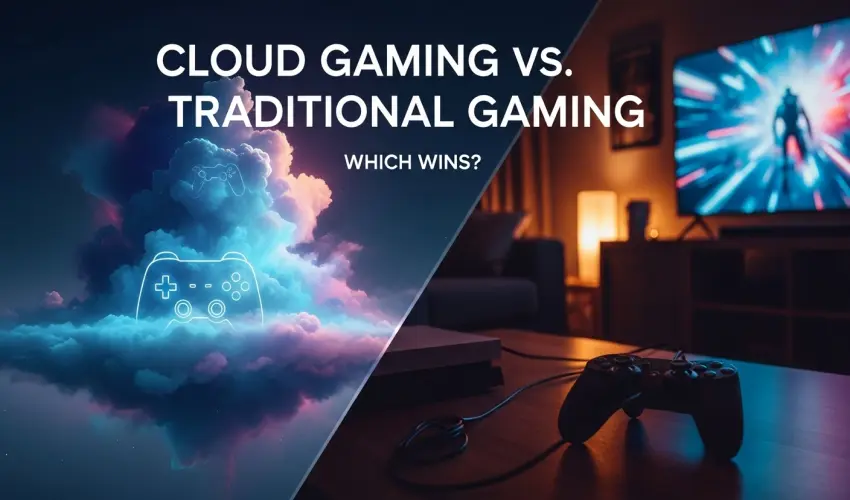Cloud Gaming vs. Traditional Gaming – Which Wins?
Published Apr 20, 2025
1 0
Key Takeaways
-
Cloud Gaming: Offers flexibility, no hardware upgrades, and instant play, but is highly dependent on a strong internet connection.
-
Traditional Gaming: Delivers unmatched performance, true game ownership, and modding capabilities, but often requires high upfront costs.
-
Closing the Gap: Cloud gaming services like Xbox Cloud Gaming, GeForce NOW, and PlayStation Plus are rapidly improving in quality and reducing latency.
-
The Crown Holders: Traditional consoles and PCs still dominate in terms of game exclusives and the competitive gaming scene.
-
The Verdict: For casual players, cloud gaming is rising fast. For competitive or offline-first gamers, traditional gaming still leads—for now.
Introduction: The Battle for the Future of Gaming
Gaming has evolved from cartridges and discs to cloud-powered streams. We’re now living in a time where you can boot up Red Dead Redemption 2 on a phone or play Cyberpunk 2077 without owning a high-end gaming PC. This is the promise of cloud gaming—a revolutionary model that delivers top-tier gaming experiences through the internet.
But how does it really stack up against tried-and-true traditional gaming on consoles or PCs? In this article, we break down both formats, compare their strengths and weaknesses, and ultimately answer: which one wins in 2025?
What is Cloud Gaming?
Cloud gaming (or gaming-as-a-service) lets you stream games directly from remote servers to your device. Think of it like Netflix for games—no downloads, no installations, no waiting.
Major Services in 2025:
-
Xbox Cloud Gaming (xCloud)
-
NVIDIA GeForce NOW
-
Amazon Luna
-
PlayStation Plus Cloud Streaming
-
Boosteroid & Shadow
Instead of a powerful GPU in your device, all the heavy processing happens in a data center. All you need is a screen and a stable internet connection.
What is Traditional Gaming?
Traditional gaming refers to running games locally on your own hardware, such as a PC, console, or handheld device. This includes platforms like:
-
PC (Steam, Epic Games Store)
-
Consoles (PlayStation 5, Xbox Series X, Nintendo Switch)
-
Offline disc and cartridge gaming
For decades, this has been the gold standard, offering maximum performance, graphical fidelity, and control.
Performance: Cloud vs. Hardware
When it comes to raw performance, the winner depends on your priorities.
Traditional Gaming Wins in:
-
Ultra-low latency and no input delay.
-
The highest possible graphical fidelity, including native 4K with ray tracing.
-
Smooth, reliable offline performance.
Cloud Gaming Advances:
-
Latency has improved drastically with edge computing and AI-based prediction.
-
Services like the GeForce NOW RTX 4080 tier offer 120+ FPS streaming with DLSS support.
However, cloud gaming can still suffer from input lag, buffering during network dips, and lower frame rates or resolution under pressure. If you're a competitive player who loves fast-paced FPS, racing, or fighting games, traditional gaming remains unmatched.
Cost Comparison: Upfront vs. Subscription
Traditional Gaming:
-
Expensive upfront: $500+ for a console or $1,000+ for a gaming PC.
-
Game Costs: Games typically cost $50 to $70 each.
-
Ongoing Costs: Potential upgrades for peripherals and components.
Cloud Gaming:
-
Low entry cost: Usually just a subscription fee (e.g.,
20/month).10– -
No hardware upgrades needed.
-
Play on devices you already own, like phones, tablets, and smart TVs.
Over a 2-3 year period, cloud gaming is often more affordable, especially for casual gamers.
Internet Dependency
This is cloud gaming's biggest weakness. It requires a consistent, fast internet connection to work well.
-
Minimum: 15 Mbps
-
Ideal: 50+ Mbps (wired or 5GHz Wi-Fi)
Traditional gaming has the clear advantage here, offering a perfect experience for offline play, rural areas, or low-bandwidth environments.
Game Library, Mods & Ownership
Traditional Gaming:
-
Access to nearly all major AAA titles and indie games.
-
Platform exclusives (like Spider-Man on PS5 or Halo on Xbox).
-
Physical ownership: Buy it once, play it forever.
-
Full support for mods, user-generated content, and customizations.
Cloud Gaming:
-
Libraries vary by service, and not all games are available.
-
DRM can restrict access, and games can be removed from the service.
-
No modding support: You play what the service provides, how it's provided.
For power users, modders, and content creators, traditional setups are still the way to go.
Accessibility & Convenience
This is where cloud gaming truly shines.
-
No installs or updates: Click and play instantly.
-
Play on any device: Switch from your laptop to your phone to your TV seamlessly.
-
Resume your session from anywhere.
Cloud gaming lowers the barrier to entry, making high-end gaming accessible to everyone.
Competitive & eSports Play
Professional eSports rely on frame-perfect precision and ultra-low latency. That’s why traditional hardware completely dominates this space. You won’t see a major CS:GO or Valorant tournament played over the cloud (at least, not yet). Until cloud gaming can guarantee zero latency, competitive players will stick to local hardware.
The Hybrid Future: Best of Both Worlds?
The lines are blurring, and we’re heading into a hybrid gaming world.
-
Services like Xbox Game Pass Ultimate offer both cloud streaming and local install options.
-
Consoles are paired with cloud services (PS5 + PS Cloud, Xbox Series X + xCloud).
-
"Stream while you download" features let you play instantly while the full game installs in the background.
Final Verdict: Who Wins in 2025?
There is no single winner, but there is a clear direction for different types of players.
Cloud Gaming is Best For:
-
Casual or mobile-first gamers.
-
People who don't own or can't afford high-end hardware.
-
Users who value flexibility and instant access over ownership.
Traditional Gaming is Best For:
-
Hardcore and competitive gamers.
-
Modders, streamers, and content creators.
-
Gamers who value offline access, peak performance, and permanence.
For everyday gaming, cloud services are nearly ready to dominate. But for now, traditional gaming still holds the crown in performance, customization, and reliability.
Conclusion
Cloud gaming is no longer a gimmick; it’s a growing powerhouse reshaping how we play. It’s accessible, cost-effective, and incredibly convenient. But it’s not a total replacement—yet.
Traditional gaming is still alive and thriving, offering control, raw power, and a more tactile sense of ownership. Ultimately, the best choice depends on your internet, your budget, and your gaming style. Whether you're all in on the cloud or sticking to your trusty console, in 2025, the choice is yours.







